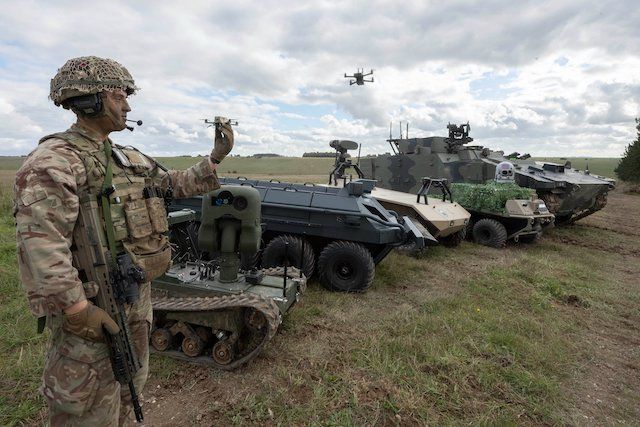Get the weekly SPARTANAT newsletter.
Your bonus: the free E-Book from SPARTANAT.

The UGVs are coming. Robotics on the battlefield.
The integration of robotics technology in commercial and military sectors is rapidly evolving, with potential implications for various industries. As driverless cars and robot-controlled delivery vehicles become more common, there is a growing need to address security and operational challenges in autonomous military vehicles.
The introduction of robotics technology has gained momentum over the past ten years and has impacted a variety of sectors. In commercial technology - where innovations typically occur and flow into industrial and military use - we have seen gradual changes in the adoption of robots and AI. For example, many countries are exploring driverless cars - some will allow them on the road this year - and the first robot-controlled delivery vehicles were introduced in 2018, potentially revolutionizing an entire industry.
While robotics and artificial intelligence have been widespread in the military sector for some time, we are now entering an era of increasing sophistication - just as in the commercial sector. So what can we expect in the near future from the technological takeover supported by commercially-driven research and development? And to what extent are robots and artificial intelligence vulnerable to manipulation by the opposing forces as they become more widespread, and how can this threat be neutralized?
Robot vehicles in the military sector
While robot vehicles originally come from the civilian sector, the requirements they must meet in a military context are quite different. Robot vehicles must be highly automated and provide tactical mobility - a good example is the use of manned and unmanned ground platforms. UGV - Unmanned Ground Vehicle - is generally an unmanned ground vehicle. These vehicles can provide logistical support on the battlefield and in urban environments, where they can be used as light patrol vehicles to reduce the burden on troops by transporting supplies, ammunition, and casualties. They can also be autonomously deployed for reconnaissance and detection missions, delivering items, and acting as decoys in certain cases.
Due to military requirements, the vehicles must be highly maneuverable and have a low signature visible both in profile and in the RF spectrum to prevent the enemy from identifying and locating them.
So, what insights from the commercial sector can we transfer to the battlefield to achieve operational advantages and prevent enemy manipulations?
Autonomy and Data Protection
The security of autonomous vehicles is of utmost importance in the civilian sector. For instance, Tesla vehicles feature multiple automatic safety features such as a collision warning system and an automatic braking system, emphasizing safety. These types of collision avoidance technologies that enhance safety in pedestrian environments could enable the remote deployment of autonomous vehicles in a military scenario without posing significant risk to nearby operating soldiers.
However, autonomous military vehicles are constantly exposed to the threat of hacker attacks that could compromise the vehicle's control as well as the data stored in it and transmitted over the command chain. In these cases, not only the vehicle itself becomes a weapon, but also its built-in sensors, equipment, and, if installed, its remote weapon system.
Here, collaboration and information exchange with the commercial sector could support the development of algorithms, AI technology, and software suitable for the military sector. By turning to the commercial sector and building on its existing technology, the military sector could benefit from a faster and more efficient development of military-grade autonomous vehicles that provide operational advantages without compromising security. The United Kingdom's recent Integrated Review of Security, Defence, Development and Foreign Policy places a clear emphasis on cyber and electronic warfare, which could give the United Kingdom a leading role in the development of autonomous military vehicles through collaboration with technology already deployed in the commercial sector.
Practical Aspects
In addition to the vehicle itself, other functions need to be considered, such as the vehicle's fuel or power source. The transition to electric vehicles in the commercial sector is advancing rapidly, enabled by the development of supporting infrastructure in the form of charging stations. But how should electric or hybrid vehicles be charged in operation? How could their battery life be extended to meet operational requirements? While further developments are needed, this is another opportunity to draw inspiration from commercial technology to explore how the vehicle's energy can be redirected, for example, by harnessing kinetic energy generated by the wheels or through solar power.
Other practical aspects of autonomous military vehicles need to be examined, such as how they can be transported to the front or military bases around the world. Could they be installed in helicopters or airplanes to increase operational flexibility? Further research and collaboration are needed here, but solutions must be sought that are practical and do not add operational complexity that the robots were meant to reduce.
Marlborough Communications Limited online
More UGV on SPARTANAT
- PROBOT in Bundeswehr Test: Flexible with the Infantry
- Robotics in the Field: MISSION MASTER for the Netherlands
- RHEINMETALL: MISSION MASTER - Cargo for the British
- RHEINMETALL MISSION MASTER impresses in live fire
- JAEGAR-C autonomously attacks in swarms
- AARDVARK: Many Little Helpers
SPARTANAT is the online magazine for Military News, Tactical Life, Gear & Reviews.
Send us your news: [email protected]
Ad
similar
Get the weekly SPARTANAT newsletter.
Your bonus: the free E-Book from SPARTANAT.


